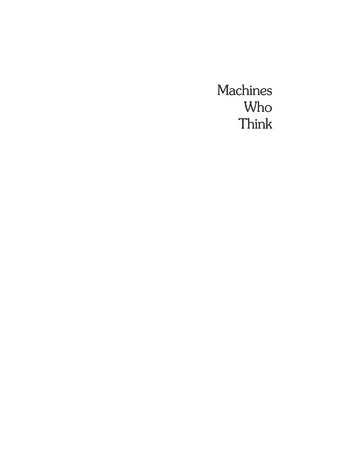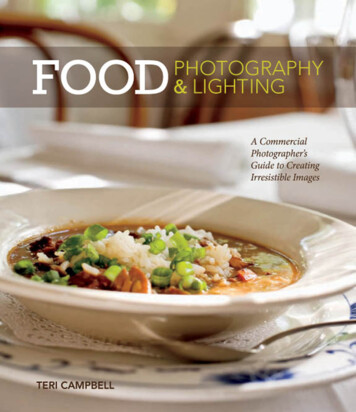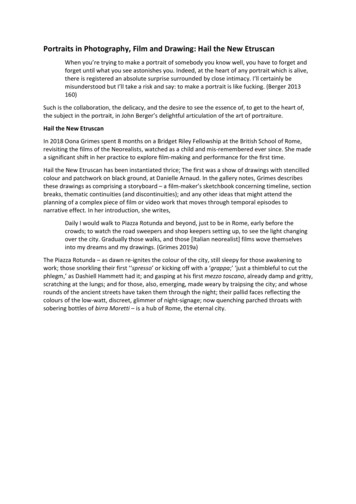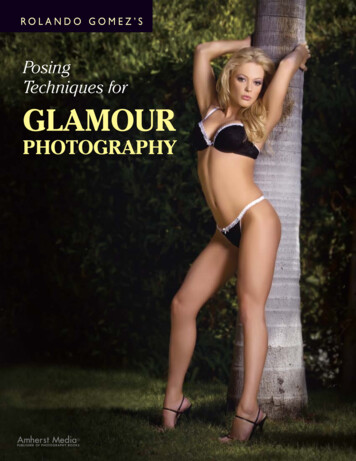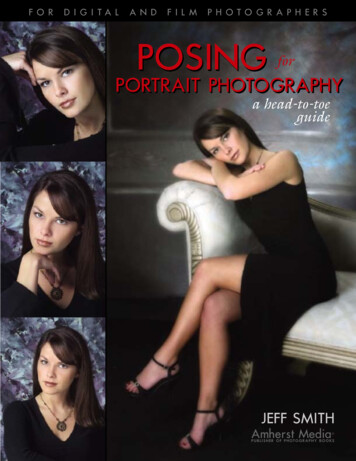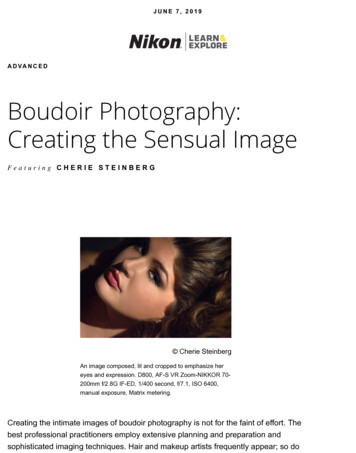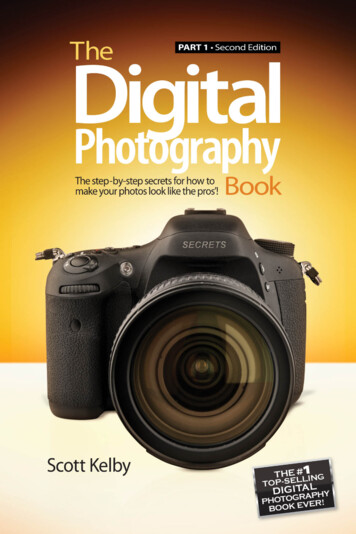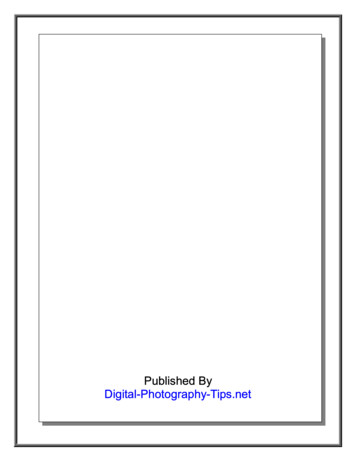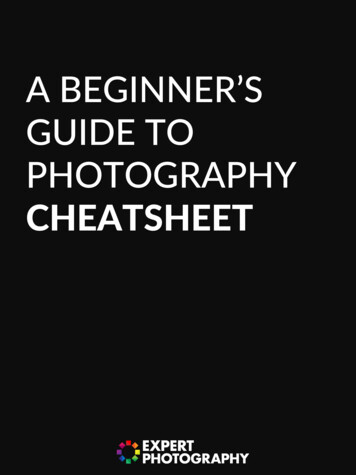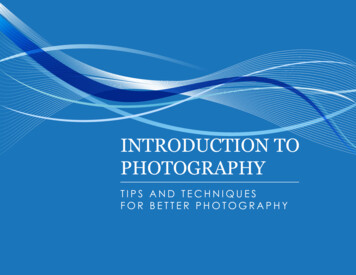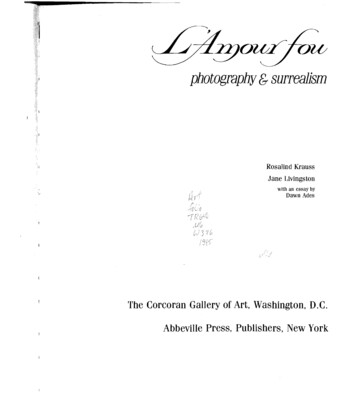
Transcription
photography & surreaJjsmRosalind KraussJane Livingstonwith an essay byDawn AdesThe Corcoran Gallery of Art, Washington, D.C.Abbeville Press, Publishers, New York
\Designers: Alex and Caroline Castro,Hollowpress, BaltimoreEditor: Alan AxelrodProduction manager: Dana Cole(c) 1985 Cross River Press, Ltd.All rights reserved under International and Pan-American CopyrightConventions. No part of this book may be reproduced or utilized inany form rby any means, electronic or mechanical, includingphotocopying, recording, or by any information storage andretrieval system, without permission in writing from the Publisher.Inquiries should be addressed to Abbeville Press, Inc . 505 ParkAvenue, New York 10022.Printed and bound in Hong Kong.Library of Congress Cataloging in Publication DataKrauss, Rosalind E.L'amour fou.Issued in conjunction with an exhibition held at theCorcoran Gallery of Art, Sept.-Nov., 1985.Bibliography: pIncludes index.Contents: Preface/Rosalind Krauss and JaneLivingston Photography in the service of surrealism!Rosalind Krauss-Man Ray and surrealist photography!Jane Livingston-[ete.]1. Photography, Artistic-Exhibitions. 2. SurrealismExhibitions. !. Livingston, Jane. II. Ades, Dawn,111, Corcoran Gallery of Art. IV. Title.TR646.U6W3761985ISBN 0-89659-576-5ISBN 0-89659-579-X (pbk.)779'.09'0485-5976Picture credits:Works by Bellmer, Ubac, Man Ray A.D.A.G.P . ParisIV.A.G.A .New York, 1985.Works by Brassa'i copyright Gilberte Brassa'i.Works by Dali, Ernst, Hugnet S.P.A.D.E.M . ParisIV.A.G.A . NewYork, 1985.Works by Rene Magritte Georgette Magritte, 1985.Works by Leo Malet reproduced with the permission of the artist.Works by Lee Miller Lee Miller Archives, 1985.Works by Roger Parry reproduced with the permission of MadeleineParry.Works by Roland Penrose Roland Penrose, 1985.
ContentsPrefaceROSALIND KRAUSS9andJANE LIVINGSTONPhotography in the Service of Surrealism15ROSALIND KRAUSSCorpus Delicti57ROSALIND KRAUSSMan Ray and Surrealist Photography115JANE LIVINGSTONPhotography and the Surrealist Text155DAWN ADESArtist Biographies and BibliographiesCompiled by WINIFREDIndex195SCHIFFMAN239
1I1IIj,1IJIIIi\fJPhotography jn the Servjce of SurreaJjsmRosalind Krauss
L'AMOUR FOUFig. 6. Man Ray, Monument iJ D. A. F. de Sade, 1933. Vera and Arturo Schwarz Collection, Milan.14l
When wifl we have sleeping logicians, sleeping philosophers?I would like to sleep, in order to surrender myself to the dreamers, , ,-Manifesto of Surrealism'II\ItHere is a paradox, It would seem that there cannot besurrealism and photography, but only surrealism orphotography, For surrealism was defined from the startas a revolution in values, a reorganization of the veryway the real was conceived, Therefore, as its leader andfounder, the poet Andre Breton, declared, "for a totalrevision of real values, the plastic work of art will eitherrefer to a purely internal model or will cease to exist.'"These internal models were assembled when consciousness lapses, In dream, in free association, in hypnoticstates, in automatism, in ecstacy or delirium, the "purecreations of the mind" were able to erupt,Now, if painting might hope to chart these depths,photography would seem most unlikely as a medium, Andindeed, in the First Manifesto of Surrealism (1924),Breton's aversion to "the real form of real objects"expresses itself in, for example, a dislike of the literaryrealism of the nineteenth-century novel disparaged, precisely, as photographic, "And the descriptions!" he deplores, "Nothing compares to their nonentity: they aresimply superimposed pictures taken out of a catalogue,the author, " takes every opportunity to slip me thesepostcards, he tries to make me see eye to eye with himabout the obvious,"3 Breton's own "nove]" Nadja (1928),which was copiously illustrated with photographs exactlyto obviate the need for such written descriptions, disappointed its author as he looked at its "illustrated part."For the photographs seemed to him to leave the magicalplaces he had passed through stripped of their aura,turned "dead and disillusioning.'"But that did not stop Breton from continuing to act onthe call he had issued in 1925 when he demanded, "andwhen will all the books that are worth anything stopbeing illustrated with drawings and appear only withphotographs?,,5 The photographs by Man Ray and Brassa'!that had ornamented the sections from the novel L 'Amourfou (1937) that had first appeared in the surrealistperiodical Minotaure survived in the final version, faithfully keyed to the text with those "word-for-word quotations ' , , as in old chambermaid's books" that had sofascinated the critic Walter Benjamin when he thoughtabout their anomolous presence, Thus in one of the mostcentral articulations of the surrealist experience of the1930s, photography continued, as Benjamin said, to"intervene,"6Indeed, it had intervened all during the 1920s in thejournals published by the movment, journals that continually served to exemplify, to define, to manifest, what itwas that was surreal. Man Ray begins in La Revolutionsurrealiste, contributing six photographs to the first issuealone, to be joined by those surrealist artists like Magritte, who were experimenting in photomontage and later, inLe Surrealisme au service de la revolution, bY,Breton aswell, In Documents it was Jacques-Andre BOiffard whomanifested the sensibility photographically, And by thetime of Minotaure's operation, Man Ray was workingalong with Raoul Ubac and Brassat But the issue is notjust that these books and journals contained photographs-or tolerated them, as it were, The more important fact is that in a few of these photographs surrealism15
L'AMOUR FOUFig. 8. Jacques-Andre Boiffard, Untitled (for Nadia), 1928.Collection Lucien Treillard, Paris.Fig. 9. Jacques-Andre Boiffard, Untitled (for Nadia), 1938.Collection Lucien Treillard, Paris.pages16-17, Fig. 7. Man Ray, Untitled, 1933. Private collection, Paris.18
PHOTOGRAPHY IN THE SERVICE OF SURREALISMin fact constitute some kind of unified visual field? Andcan we conceive this field as an aesthetic category?What Breton himself put together, however, in thefirst Surrealist Manifesto was not so much an aestheticcategory as it was a focus on certain states of minddreams-certain criteria-the marvelous-and certainprocesses-automatism. The exempla of these conditionscould be picked up, as though they were trouvaiIIes at aflea market, almost anywhere in history. And so Bretonfinds the "marvelous" in "the romantiC ruins, the modernmannequin . . Villon's gibbets, Baudelaire's couches."8And his famous incantatory list of history's surrealistsis precisely the demonstration of a "found" aesthetic,rather than one that thinks itself through the formalcoherence of, say, a period style:achieved some of its supreme images-images of fargreater power than most of what was done in theremorselessly labored paintings and drawings that cameincreasingly to establish the identity of Breton's conceptof "surrealism and painting,"If we look at certain of these photographs, we seewith a shock of recognition the simultaneous effect ofdisplacement and condensation, the very operations ofsymbol formation, hard at work on the flesh of the real.In Man Ray's Monument il D. A F. de Sade (fig. 6), forexample, our perception of nude buttocks is guided byan act of rotation, as the cruciform inner "frame" forthis image is transformed into the figure of the phallus.The sense of capture that is simultaneously implied bythis fall is then heightened by the structural reciprocitybetween frame and image, container and contained. Forit is the frame that counteracts the effects of the lightingon the flesh, a luminous intensity that causes the nudebody to dissolve as it moves with increasing insubstantiality toward the edges of the sheet, seeming as it goesto become as thin as paper. Only the cruciform edges ofthe frame, rhyming with the clefts and folds of thephotographed anatomy, serve to reinject this field witha sense of the corporeal presence of the body, guarantyingits density by the act of drawing limits. But to call thisbody into being is to eroticize it forever, to freeze it asthe symbol of pleasure. In a variation on this theme oflimits, Man Ray's untiLled Minotaure image (fig. 7)displaces the visually decapitated head of a body downward to transform the recorded torso into the face of ananimal. And the cropping of the image by the photographicframe, a cropping that defines the bull's physiognomy bythe act of locating it, as it were-this cutting mimes thebeheading by shadow that is at work inside the image'sfield. So that in both these photographs a transformationof the real occurs through the action of the frame. Andin both, each in its own way, the frame is experiencedas figurative, as redrawing the elements inside it. Thesetwo images by Man Ray, the work of a photographer whoparticipated directly in the movement, are stunninginstances of surrealist visual practice. 7 But others,qualifying equally for this position as the "greatest" ofsurrealist images, are not really by "surrealists." Brassa'i's Involuntary Sculptures (Sculptures involuntaires;figs. 10, 28, 29, 30, 31) or his nudes for the journalMinotaure are examples. And this fact would seem toraise a problem. For how, with this blurring of boundaries,can we come to understand surrealist photography? Howcan we think of it as an aesthetic category? Do thephotographs that form a historical cluster, either asobjects made by surrealists or chosen by them, do theySwift is Surrealist in malice,Sade is Surrealist in sadism.Chateaubriand is Surrealist in exoticism.Constant is Surrealist in politics.Hugo is Surrealist when he isn't stupid.8In the beginning the surrealist movement may have hadits members, its paid-up subscribers, we could say, butthere were many more complimentary subscriptions beingsent by Breton to far-off places and into the distantpast WThis attitude, which annexed to surrealism such disparate artists as Uccello, GustaveMoreau, Seurat, andKlee, seemed bent on dismantling the very notion of style.One is therefore not surprised at the position the poetand revolutionary Pierre Naville took up against the"Beaux-Arts" when he limited the visual aesthetic of themovement to memory and the pleasure of the eyes. andproduced a list of those things that would produce thispleasure: streets, kiosks, automobiles, cinema, photographsl1 In modeling what he intended as the movement'sauthoritative journal, La Revolution surrealiste, after theFrench SCientific review La Nature, Naville wanted toclarify that this was not an artiTIagazine, and his deCision.as its editor, to include a great deal of photography waspredicated precisely, he has said, on the availability ofphotography's images-one could find them anywhere 12For Naville, artistic style was anathema. "I have notastes," he wrote, "except distaste. Masters, mastercrooks, smear your canvases. Everyone knows there isno surrealist painting. Neither the marks of a pencilabandoned to the accidents of gesture, nor the imageretracing the forms of the dream. "13To place in this way a ban on accident and dream asthe basis of a visual style, thereby proscribing the very19
L'AMOUR FOUresources on which Breton depended, was to make ofhimself a kind of roadblock in the direction along whichsurrealism was moving. Naville's struggle with Breton isacted out in the masthead of La Revolution surrealiste,which is issued at its beginning from its rue de Grenelleheadquarters, dubbed the "Centrale," its editors listedas Naville and Peret, then is wrested from them in thethird issue by Breton and moved to the rue Fontaine,only to return for one number to the Centrale, until it isdefinitively taken back home by Breton to the rueFontaine. Many things were at issue in this struggle, butone of them was painting. For by the middle of 1925Breton had allowed the possibility of "Surrealism andPainting," in the text he produced by that name. At firsthe thought of it in terms of "found" surrealists, like deChirico or Picasso. But by March 1926 his secondinstallment of this essay was bent on constructingprecisely what "everyone knows" there is none of: apictorial movement, a stylistic phenomenon, a surrealistpainting to go into the newly organized Galerie Surrealiste.In going about formulating this thing, this style, Bretonresorted to his very own privileging of visuality, when inthe first Manifesto he had located his own invention ofpsychic automatism within the experience of hypnogogicimages-that is, of half-waking, half-dreaming visualexperience. For it was out of the priority that he wantedto give to this sensory mode-the very medium of dreamexperience-that he thought he could institute a pictorialstyle."Surrealism and Painting" thus begins with a declaration of the absolute value of vision above the othersenses." Rejecting symbolism's notion that art shouldaspire to the condition of music, Breton rejoins that"visual images attain what music never can," and headds, no doubt for the benefit of twentieth-centuryproponents of abstraction, "so may night continue todescend upon the orchestra." Breton had opened byextolling vision in terms of its absolute immediacy, itsresistance to the alienating powers of thought. "The eyeexists in its savage state," he had begun. "The marvelsof the earth . have as their sale witness the wild eyethat traces all its colors back to the rainbow." Vision,defined as primitive or natural, is good; it is reason,calculating, premeditated, controlling, that is bad.No sooner, however, is the immediacy of vision established as the grounds for an aesthetic, than it is overthrown by something else, something normally thoughtto be its opposite: writing. Psychic automatism is itselfa written form, a "scribbling on paper," a textualproduction. Describing the automatic drawings of AndreMasson-the painter whose "chemistry of the intellect"Breton was most drawn to-Br
simply superimposed pictures taken out of a catalogue, the author, " takes every opportunity to slip me these postcards, he tries to make me see eye to eye with him about the obvious,"3 Breton's own "nove]" Nadja (1928), which was copiously illustrated with photographs exactly to obviate the need for such written descriptions, dis appointed its author as he looked at its "illustrated part .
